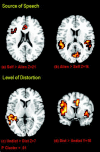Neural correlates of the misattribution of self-generated speech
- PMID: 15884023
- PMCID: PMC6871759
- DOI: 10.1002/hbm.20120
Neural correlates of the misattribution of self-generated speech
Abstract
Auditory hallucinations are thought to arise through the misidentification of self-generated verbal material as alien. The neural mechanisms that normally mediate the differentiation of self-generated from nonself speech are unclear. We investigated this in healthy volunteers using functional MRI. Eleven healthy volunteers were scanned whilst listening to a series of prerecorded words. The source (self/nonself) and acoustic quality (undistorted/distorted) of the speech was varied across trials. Participants indicated whether the words were spoken in their own or another person's voice via a button press. Listening to self-generated words was associated with more activation in the left inferior frontal and right anterior cingulate cortex than words in another person's voice, which was associated with greater engagement of the lateral temporal cortex bilaterally. Listening to distorted speech was associated with activation in the inferior frontal and anterior cingulate cortex. There was an interaction between the effects of source of speech and distortion on activation in the left temporal cortex. In the presence of distortion participants were more likely to misidentify their voice as that of another. This misattribution of self-generated speech was associated with reduced engagement of the cingulate and prefrontal cortices. The evaluation of auditory speech involves a network including the inferior frontal, anterior cingulate, and lateral temporal cortex. The degree to which different areas within this network are engaged varies with the source and acoustic quality of the speech. Accurate identification of one's own speech appears to depend on cingulate and prefrontal activity.
Figures




References
-
- Allen PP, Johns LC, Fu CH, Broome MR, Vythelingum GN, McGuire PK (2004): Misattribution of external speech in patients with hallucinations and delusions. Schizophr Res 69: 277–287. - PubMed
-
- Binder JR, Frost JA, Hammeke TA, Bellgowan PS, Springer JA, Kaufman JN, Possing ET (2000): Human temporal lobe activation by speech and nonspeech sounds. Cereb Cortex 10: 512–528. - PubMed
-
- Brammer MJ, Bullmore ET, Simmons A, Williams SC, Grasby PM, Howard RJ, Woodruff PW, Rabe‐Hesketh S (1997): Generic brain activation mapping in functional magnetic resonance imaging: a nonparametric approach. Magn Reson Imag 15: 763–770. - PubMed
Publication types
MeSH terms
LinkOut - more resources
Full Text Sources

